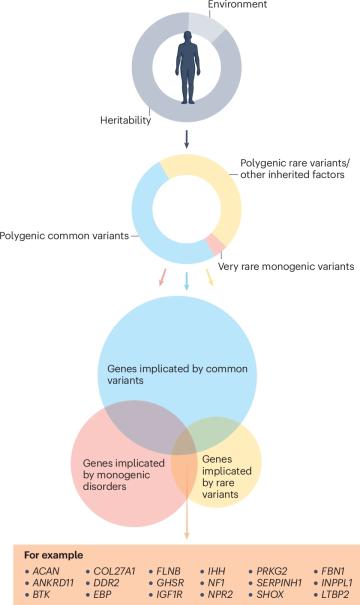The Genetics of Height
A fascination with the heredity of height has led to insights about the biology of growth and disease
Summer 2025
- 6 min read
- Feature
Geneticist Joel Hirschhorn learns he’s five feet, nine inches tall — with shoes on.
Photo: John Soares

Geneticist Joel Hirschhorn learns he’s five feet, nine inches tall — with shoes on.
Photo: John Soares
Even before the word “genetics” existed, there were scientists who understood that parents pass down traits to children. Some of the clearest clues came from patterns in people’s height.
“Height is one of the first things you notice about people,” says Joel Hirschhorn, MD ’95 PhD ’95, an HMS professor of genetics, the HMS Concordia Professor of Pediatrics, and chief of the division of endocrinology at Boston Children’s Hospital. “It’s easy to measure. And it’s pretty obvious that tall parents tend to have tall children and short parents tend to have short children.”
Although that link may be obvious, understanding its nuances has never been simple. Hirschhorn, who coauthored a recent review on the genetics of human height in Nature Reviews Genetics, has spent decades untangling precisely how genes influence stature. His work has built upon that of many past geneticists who have been drawn to height because of its power to reveal hints about human health, from the biology of growth to the nature of heredity itself.
Polygenes and peas
To appreciate just how important height has been in genetics, it’s worth taking a step back to the turn of the twentieth century, when studies of height were at the center of fierce debates about how inheritance works.
On one side, Hirschhorn says, there were scientists studying people with severe alterations in stature who found patterns running in families. They argued that height behaved like Gregor Mendel’s garden peas: just as the peas could be tall or dwarfed, height could be passed down in one of two forms. But when other researchers plotted graphs with the heights of many people, they found that human height didn’t behave like the peas. Instead, it followed a bell curve, with few people being very tall or short and many people falling somewhere in-between.

Both camps used studies of height to argue they’d figured out how human genetics works. “And both were right,” says Hirschhorn. “Or both were wrong, depending how you look at it.”
In 1918, British statistician Ronald Fisher settled the debate. He argued that multiple genes contribute to variation in height, each of which follow Mendelian rules of inheritance. “Each one of these genes makes you a little taller, a little shorter, and they all sort of add together,” says Hirschhorn. “It works like Mendel, but it actually ends up resulting in a normal curve in the real world.”
Using the example of height, Fisher had come up with the idea of a polygenic trait: a characteristic shaped by the cumulative effects of many changes in the genetic code that vary between individuals. It’s a concept that applies to countless human characteristics, from skin color and weight to the likelihood of developing cancer or heart disease.
“Height is the classic polygenic trait,” Hirschhorn says. “Because it’s so easily measured, we can get very large datasets. We can get further in understanding how polygenic traits work, and that presumably gives us lessons we can apply to other polygenic traits and diseases.”
A tall order
Hirschhorn originally got interested in height for personal reasons. Not because he’s unusually tall or short — “I am of average height, although I think I’ve shrunk,” he quips — but because of his daily experience in the clinic. Short stature is one of the most common reasons parents bring children to see a pediatric endocrinologist. During his fellowship in the field in the 1990s, Hirschhorn sometimes saw children who were growing more slowly than their peers — but a quick glimpse at the parents would indicate the slow growth was likely due to harmless genetic disposition.
“I used to tell the parents, there’s a lot of genes that you carry, and you’ve passed some of the shorter ones to your child, but we don’t know what those genes are,” he recalls. After repeating “we don’t know” dozens of times, Hirschhorn realized it was something he might just be able to figure out.
Although eighty-plus years had passed since Fisher’s influential paper, scientists hadn’t made much progress in pinpointing the common genetic variants that shape height. They knew that about 80 to 90 percent of height is shaped by genetics, with environmental factors playing a smaller role. And by studying family histories, they’d identified hundreds of monogenic traits: single, rare genetic variants that can have large effects on height. But since most people’s stature is instead shaped by small variations in thousands of genes, just tracking family history wasn’t enough to identify the common variants involved.
Thanks to advances in DNA sequencing in the early 2000s, though, a new tool was on the horizon: the genome-wide association study, or GWAS. This technique draws from scans of the genomes of a large number of people, comparing those with a given trait to those who don’t have it and identifying genetic markers that occur more frequently in one group versus the other. Hirschhorn was an early adopter of the tool, applying it to height.
A model trait

In 2009, Hirschhorn organized the Genetic Investigation of Anthropometric Traits (GIANT) consortium, an international collaboration of scientists who pool data to conduct genome-wide association studies related to height. “First we found one gene variant linked to height. Then we found ten. Then there were a couple hundred,” says Hirschhorn, who still chairs the GIANT consortium today. The more genomic data he and collaborators could access, and the more they refined the tools used to analyze it, the more variants they uncovered. By 2022, they were able to pinpoint more than 12,000 variants reliably associated with height.
Along the way, they gleaned lessons and best practices that would go on to influence the study of other polygenic traits. While some researchers had predicted that increasing the sample size beyond a few hundred thousand individuals would yield diminishing returns, Hirschhorn and colleagues demonstrated that increasing sample size into the millions directly increased the power of GWAS to detect important variants. By the time their 2022 study was published, which included genomic data from more than five million people, they had mapped all of the regions of the genome that contained common variants influencing height. And they had reached saturation: a point at which increasing the sample size no longer significantly improved accuracy in predicting height. They had shown what is achievable for understanding polygenic traits when sample sizes are big enough.
Because a disproportionate number of the available samples came from individuals of European ancestry, though, they found that their ability to predict height was much less reliable for individuals from other backgrounds. Their work has also highlighted the importance of continued investment in genome-wide association studies that include diverse, non-European populations.
The biology of growth
Another insight Hirschhorn and colleagues revealed is that the heritability of a particular polygenic trait can be concentrated within a specific region of the genomic code, like a kind of hotspot.
As an endocrinologist focused on hormone-related conditions, Hirschhorn originally expected most of the variants influencing height to be those that control and regulate growth hormone. To his surprise, though, most of the height-related variants discovered are actually expressed in a different genomic region, one that controls the growth plate: a soft area of cartilage near the ends of children’s bones where cells divide to form new bone.
“Nature is basically telling us the biology of growth,” Hirschhorn says. “It’s saying, ‘Hey, it’s the growth plate — that’s where most of the action is.’”
The finding could have implications for future therapies, like those for yet-unexplained conditions of abnormal skeletal growth in children. For example, one of Hirschhorn’s studies found that changes in a gene called STC2 can have a relatively large influence on height. When STC2 is less active, a growth-promoting molecule called IGF-1 is more active at the growth plate, resulting in taller stature. A treatment designed to safely knock out STC2 function could therefore help promote growth.
“There are, no doubt, many other genes that have been implicated that if you found drugs to perturb them, they could affect growth,” Hirschhorn says. While he cautions that side effects would have to be better understood, he sees “lots of opportunities.”
Back in the clinic, Hirschhorn still encounters parents each day who are concerned about their children’s height. He does his best to use the tools available, like measurements of the hand, to predict what each child’s height should be and whether their growth is part of normal variation. But he hopes that the data he’s found can be incorporated into a new type of test to help doctors predict what a child’s height should be based on their genes — and therefore ascertain whether a case of slow growth is based on normal genetic variation or something more nefarious.
When he set out to research height, Hirschhorn never imagined he’d glean enough to data to make those kinds of predictions. “I had no idea we were going to get where we got,” he says. “I’m pleasantly surprised to have been proven wrong.”
Molly McDonough is the associate editor of Harvard Medicine.